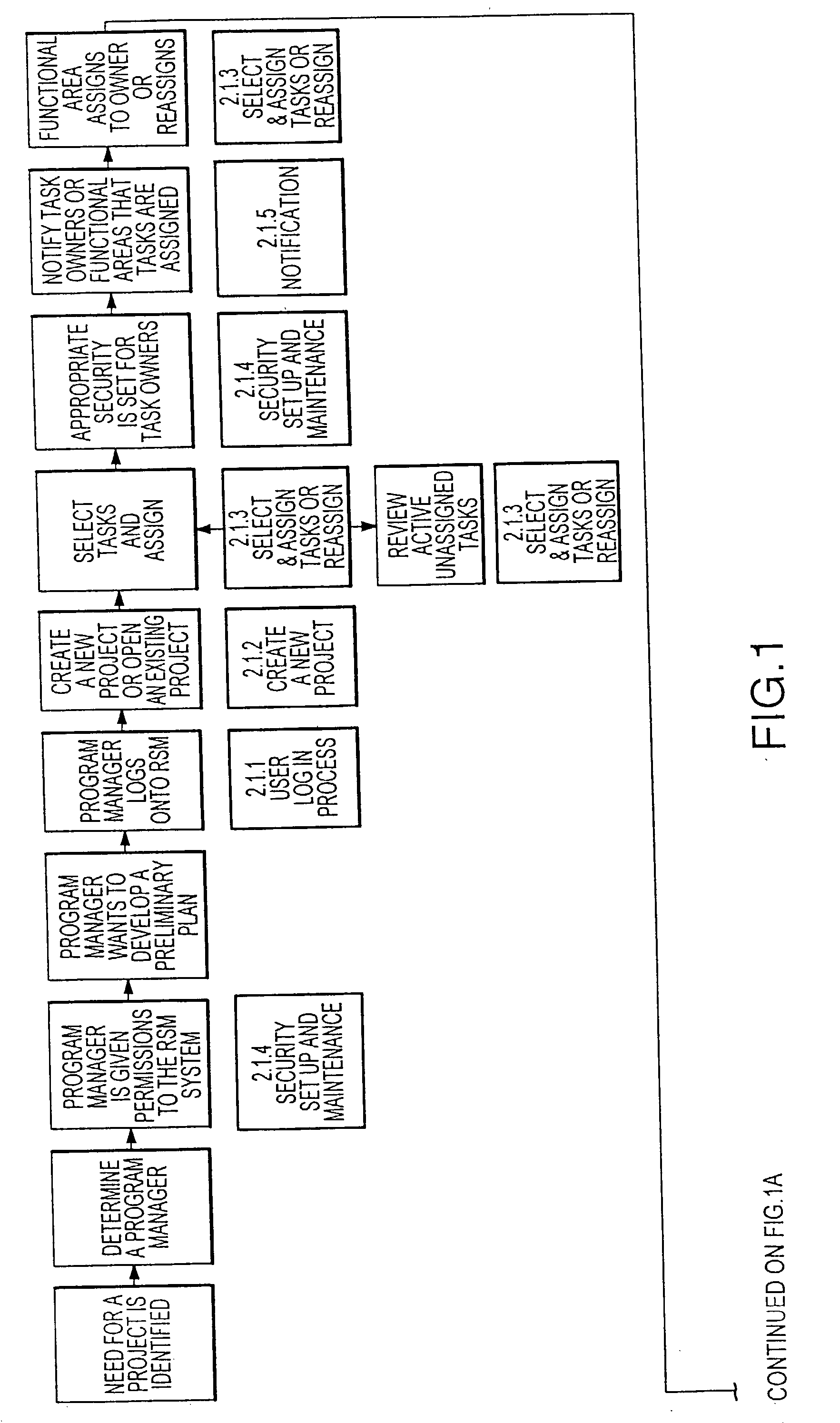A typewriter can't show you how to write a book.
Similarly scheduling tools such as Microsoft Project or Project Office can't show the user how to plan and integrate the process of product development.
As such, companies may generate ad hoc approaches to product development that are dependent upon people doing their "best" planning management, which can fail to identify, or tie various process activities or methodologies, and which can fail to provide
coherent information transfer throughout the organization.
In
spite of the variety of scheduling tools available to the
consumer, substantial problems remain unresolved with respect to providing a planning management device which assures repeatably successful integrated product development.
A significant problem with existing scheduling tools is that they are not planning systems.
Sophisticated scheduling tools, such as Project Office may integrate and update many individual schedules such as those prepared using Microsoft Project but these tools do not provide a planning
system.
A significant problem with existing scheduling tools is they assume that the user knows how to plan and manage a project.
This assumption of
subject matter expertise which may not exist with respect to coordinating the various aspects of product development may result in a failure of proper requirements identification.
Providing solutions to problems that have narrow focus, however, may fail in the first instance to properly identify all the requirements for product development, and in the second instance may fail to integrate the efforts of the entire organization.
A related problem with existing scheduling tools is that they place the burden of being a lexicographer on the user.
However, consistent use of terminology rarely cuts across an entire organization and miscommunication may occur as individuals attempt to interpret terminology within the context of their own
specialty area.
Moreover, allocation of resources by a user having little
subject matter expertise in a
specialty may result in incorrect budget allocations based upon incorrect perceptions of the activities performed in particular product development step.
Likewise, individuals with varying
subject matter expertise may incorrectly draw upon budgeted resources for product development steps when product development steps are defined by generic indicators.
Ultimately due to these miscommunications, the scheduling tool may, in-part or in its entirety, lose its usefulness as a baseline for integrating product development events and as tool for comparing the budgeted resources to the real time use of resources.
Because the product development content and resource lists remain outside of the project scheduling tool the project scheduling tool may not allow multiple users to use the project scheduling tool as a forum for interactive review and comparison.
Another problem with existing scheduling tools or spreadsheets may be that they provide few
metrics for comparing success or failure within the project or across projects.
This may result from the inability to memorialize various aspects of real time experiences in the product or service
production cycle for later review.
Another problem with existing scheduling tools may be that they do not allow for construction of consistent baseline project development plans.
Another problem with existing scheduling tools may be a lack of product development content.
These types of tools do not provide the user with interactive subject matter expertise about the product being developed, about resources to perform activities, or about the activities themselves.
The scheduling tool may not link the details of such content into useful packets of information for the user, or show the user how to create dependency between various aspects of the content.
However, the project scheduling tool or
spread sheet formats may not show the user how to plan a project resulting in resources to be entered into these databases external from the
project planning.
A related problem may be that existing scheduling tools may not allow product development content to be entered into the functional shell of the project scheduling tool.
Another problem may be that existing scheduling tools do not provide guidance in assigning dependencies between product development content.
Another problem may be that existing project scheduling tools may not be loaded with sufficient product development content automatically.
Another problem may be that product development content which may be loaded automatically to existing project scheduling tools may not automatically load the assigned dependencies between product development content.
Still another problem with existing scheduling tools may be that they are too cumbersome.
A related problem is that existing scheduling tools are too labor or time intensive.
A third aspect of this problem may be that the user must acquire multi-discipline subject matter expertise before identification, integration and coordination of product development steps may occur.
Gaining subject matter expertise requires the expenditure of time to allow sufficient interaction with other persons or through academic achievement.
Another related problem is that the process of both learning to use feature rich scheduling tools, acquiring multiple-discipline subject matter expertise, and obtaining project or planning management expertise is too complicated.
 Login to View More
Login to View More  Login to View More
Login to View More 


